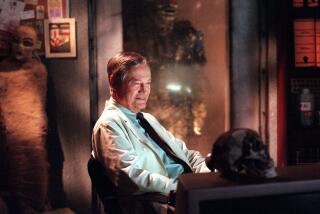Making Monsters Matter
- Share via
With this summer’s “Godzilla” a proven disappointment despite its $134-million gross, the legacy of James Whale, who essentially invented the modern monster movie, seems smarter (if less heeded) than ever.
Whale, the Hollywood director of “Frankenstein” and “The Bride of Frankenstein” in the 1930s, “invested the central character of the genre--the monster, if you will--with human qualities,” Whale’s biographer, James Curtis, says.
Those were precisely what the giant lizard was missing in the Sony Pictures remake, a miscalculation that disappointed critics and fans the world over.
“It was Whale who recognized that giving the monster human qualities would ultimately win the sympathy of the audience,” Curtis said from his home in Brea on the eve of a book tour for the newly published “James Whale: A New World of Gods and Monsters” (Faber & Faber, $22.95).
“The Creature became the protagonist, and that was absolutely unique [in Hollywood],” he added. “Admittedly, he got that straight from Mary Shelley’s [1818] novel. But what clearly interested Whale was the potential to make the monster into a real character.”
Before Whale’s “Frankenstein” (1931), the movie monster was regarded as entirely unsympathetic, a terrifying freak of nature or an infernal one.
For example, in Tod Browning’s “Dracula,” which came out a few months earlier than “Frankenstein,” Dracula is completely one-dimensional and supernatural, Curtis points out. “There’s no humanity to him. He’s interesting but alien.”
Humanizing the monster “became important in the aftermath of ‘Frankenstein,’ ” he said. “You can see that with ‘King Kong’ in 1933. What audiences found so compelling was a level of understanding and identification with the figure of horror.”
That--and the sort of droll humor Whale injected into “The Bride of Frankenstein” (1935)--became integral to many of the better, more sophisticated horror films. But if Whale had never tried his hand at the genre--he also made “The Invisible Man” (1933)--the British-born director would be remembered for such diverse classics as the 1936 musical “Show Boat” and the 1932 melodrama “The Old Dark House.”
Curtis, a 44-year-old Los Angeles native who grew up in Orange County, first became interested in Whale as a childhood fan of old Hollywood movies he saw on television. Later, while a student at Fullerton College, he saw both “The Old Dark House,” which had been considered lost, and “Show Boat” for the first time at festival screenings.
“They were a revelation to me because it was clear that the same sharp visual style, the sense of design and the humor in the horror movies were also present in those,” he recalled.
Eager to learn more about the director, who died in 1957 (a suicide, Curtis later discovered), he dashed off a letter to Carl Laemmle Jr., the retired head of Universal Pictures who had produced many of Whale’s best pictures. A note came back from Laemmle, then in his 60s but very ill, inviting the young man to his Beverly Hills home.
Laemmle put him in touch with Whales’ longtime companion, David Lewis.
“I naively asked if anybody had ever written Whale’s biography,” Curtis said. “I did not have designs on writing it myself. I just wanted to read one.”
Lewis told him nobody had and suggested he give it a try.
“I thought, ‘What the heck.’ I had nothing better to do,” Curtis recounted. “I was 21 at the time.”
With the ignorance of youth, he simply barreled ahead, calling up as many people who had known or worked with Whale as he could. In four months, he amassed a collection of interviews with actors such as Gloria Stuart (currently famous for “Titanic”), who had appeared in “The Old Dark House,” and Louis Hayward, who had starred in Whale’s 1939 swashbuckler “The Man in the Iron Mask.”
“It was just dumb luck,” Curtis said. “At one point I decided it was time to sit down at the typewriter. I couldn’t type, either. I typed the whole manuscript with one finger.”
Five months later, the budding author left a finished manuscript on Lewis’ doorstep, “kind of like when you light a fuse to a bomb and wait to see what happens.” Much to his surprise, Lewis phoned him almost immediately, having read it in a day.
“You did it,” Lewis told Curtis. “I don’t know how, but you captured Jimmy.”
A literary agent sent the manuscript to various New York publishers.
“Everywhere people said, ‘This is very nice, but we don’t see any market for it,’ ” Curtis recalled. “So it just kind of sat there. In the meantime, David said I should do another biography.”
*
This time Curtis started researching the life of Preston Sturges, another director who had fascinated him. He spoke to the Sturges family, discovered that nobody had ever approached them, and did his first interview about the director with Rudy Vallee in 1976. Six years later, his book, “Between Flops,” the first major biography of Sturges, was published by Harcourt Brace Jovanovich.
“Between Flops” drew national attention--a full page was devoted to it in Newsweek, for example--and sold well enough to get a paperback edition and remain in print for 16 years. Today, Sturges has become something of a cottage industry, with the publication of two more major biographies and three books of selected Sturges screenplays.
Despite having triggered an extraordinary groundswell of interest in Sturges--the director’s reputation is probably higher than ever--Curtis does not kid himself that his latest biography will do the same for Whale.
His main intention, in fact, was to enlarge and improve that first Whale manuscript, which eventually did find a small publisher.
“About five years ago,” Curtis said, “when nobody else had done anything on Whale, and people who had an interest in him were directed to me, I became embarrassed by what I’d written. I cringed at some of the errors. My standards had risen.”
No longer embarrassed, the author is already on to his next biography--this one for Knopf--about W.C. Fields. Again, luck played a role, he said, as he discovered previously unseen personal papers that Fields’ family has kept over the years.
“It’s great stuff that nobody knows about,” he said.
Curtis expects to deliver the book in October 2000, with publication projected for 2001. By now, he not only types with all fingers, he also uses a computer.
“It makes life much easier,” he said.
As for Whale, “Frankenstein” made the American Film Institute’s recent controversial list of the top 100 movies and, with “Show Boat,” is in the Library of Congress’ National Film Registry to preserve significant movies.
“One day,” Curtis said, “they’ll be melting prints of ‘Godzilla’ down for toothpicks.”
More to Read
Only good movies
Get the Indie Focus newsletter, Mark Olsen's weekly guide to the world of cinema.
You may occasionally receive promotional content from the Los Angeles Times.










